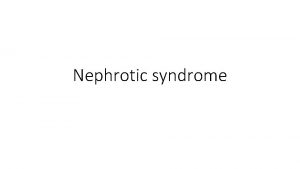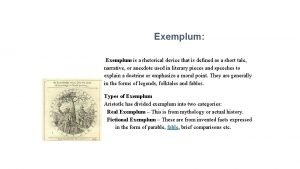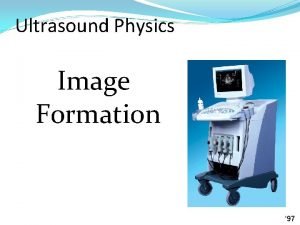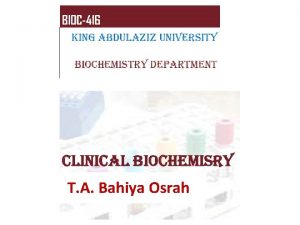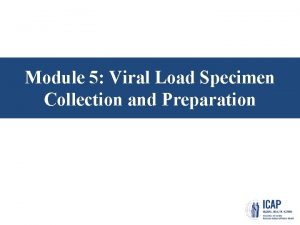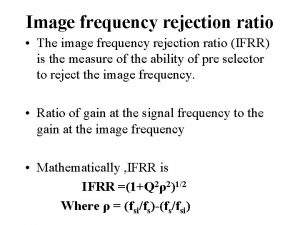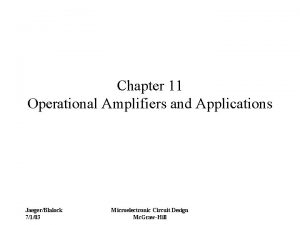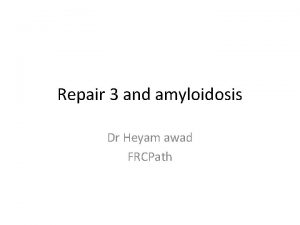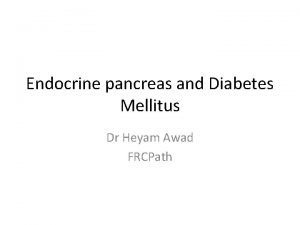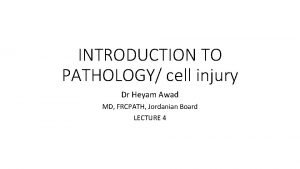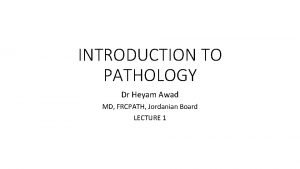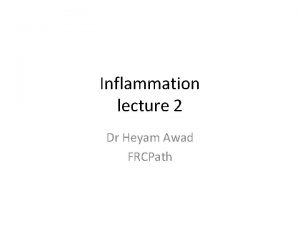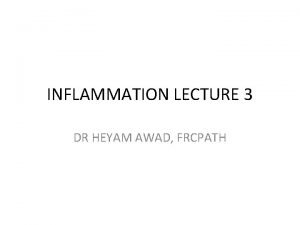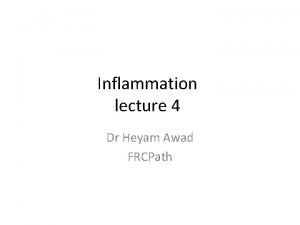Summary Amyloidosis and tissue rejection Heyam Awad Amyloidosis




















- Slides: 20

Summary. . Amyloidosis and tissue rejection Heyam Awad

Amyloidosis • Amyloidosis is a group of disorders that is associated with a number of inherited and inflammatory disorders, some of which are immunologic in nature, in which extracellular deposits of fibrillary proteins are responsible for tissue damage and functional compromise. • These abnormal fibrils are produced by the aggregation of misfolded proteins (which are soluble in their normal folded configuration). • These proteins accumulate extracellularly and cause functional compromise on adjacent tissue.

diagnosis • Amyloidosis is diagnosed on morphologic grounds. • With the light microscope and hematoxylin and eosin stains, amyloid appears as an amorphous, eosinophilic, hyaline, extracellular substance. • Special stains are used to demonstrate that this amorphous hyaline substance is amyloid, and no other fibers like collagen. The most widely used stain is the Congo red stain, which under ordinary light gives a pink or red color to tissue deposits, but with polarized microscopy this stain gives a specific green birefringence of the amyloid which differentiates it from collagen and other substances

Amyloid characteristics • All amyloid deposits have a similar appearance and staining characteristics, but amyloid is not a single chemical entity. There are more than 20 different proteins can aggregate and form fibrils with the appearance of amyloid. • SO amyloid proteins are different chemically, but all have the same physical characteristics

Physical Nature of Amyloid • By electron microscopy, all types of amyloid consist of continuous, non-branching fibrils. • They all have characteristic cross-β-pleated sheet conformation. This conformation is seen regardless of the clinical setting or chemical composition and is responsible for the distinctive Congo red staining and birefringence of amyloid

Types of amyloid proteins • The AL (amyloid light chain) protein is made up of complete immunoglobulin light chains, the amino terminal fragments of light chains, or both. • Most of the AL proteins are composed of λ light chains or their fragments, but κ chains are present in some cases. • The amyloid fibril protein of the AL type is produced from free Ig light chains secreted by a monoclonal population of plasma cells, and its deposition is associated with certain forms of plasma cell tumors.

AL Amyloid • Causes primary Amyloidosis: which is systemic and associated with plasma cell disorders • This is the most common form of amyloidosis. It occurs in 5% to 15% of individuals with multiple myeloma • The malignant plasma cells synthesize abnormal amounts of a single Ig (monoclonal gammopathy), producing an M (myeloma) protein spike on serum electrophoresis.

Bence Jones protein. . A form of of AL protein • In addition to the synthesis of whole Ig molecules, the malignant plasma cells also secrete free, unpaired κ or λ light chains (referred to as Bence-Jones protein). • These may be found in the serum, and due to their small molecular size, Bence-Jones proteins are excreted and concentrated in the urine ( so can be diagnosed by urine test) • Bence Jones proteins can cause amyloidosis but the majority of myeloma patients who have Bence Jones proteins in serum and urine do not develop amyloidosis.

The AA (amyloid-associated): • this type of amyloid fibril protein is derived from a non-Ig protein made by the liver called SAA (serum amyloid-associated) protein that is synthesized in the liver and circulates bound to high density lipoproteins. • The production of SAA protein is increased in inflammatory states as part of the acute phase response; therefore, this form of amyloidosis is associated with chronic inflammation, and is often called secondary

AA. . Continuation • It causes Secondary or Reactive Systemic Amyloidosis. • reactive systemic amyloidosis complicates rheumatoid arthritis, ankylosing spondylitis, and inflammatory bowel disease. • In this form of amyloidosis, SAA synthesis by liver cells is stimulated by cytokines such as IL-6 and IL-1 that are produced during inflammation; thus, long-standing inflammation leads to a sustained elevation

Other forms of amyloid • β-amyloid protein (Aβ) constitutes the core of cerebral plaques found in Alzheimer. • Transthyretin (TTR) is a normal serum protein that binds and transports thyroxine and retinol. Several mutant forms of TTR (and its fragments) are deposited in a group of genetically determined disorders referred to as familial amyloid polyneuropathies. Normal TTR is also deposited in the heart of aged individuals (senile systemic amyloidosis). • β 2 -microglobulin, a component of MHC class I molecules. it is fund in amyloidosis that complicates long-term hemodialysis

Endocrine amyloid • Microscopic deposits of localized amyloid may be found in certain endocrine tumors, such as medullary carcinoma of the thyroid gland , islet tumors of the pancreas and pheochromocytomas

Amyloid of Aging. • Several forms of amyloid deposition occur with aging. • Senile systemic amyloidosis refers to the systemic deposition of amyloid in elderly patients (usually in their 70 s and 80 s). • Because of the dominant involvement and related dysfunction of the heart, this form was previously called senile cardiac amyloidosis. Patients present with a restrictive cardiomyopathy and arrhythmias The amyloid in this form is derived from normal TTR

Inherited familial Amyloidosis: • There is a variety of familial forms of amyloidosis, the most common is familial Mediterranean fever which is an autosomal recessive disease you will see in the pediatric rotations as it is common among Arabs. • This is an “autoinflammatory” syndrome associated with excessive production of the cytokine IL-1 in response to inflammatory stimuli. Patients have fever accompanied by inflammation of serosal surfaces, including peritoneum, pleura, and synovial membrane (that’s why patients have abdominal pain and joint pain)

Graft rejection • The host immune system recognizes graft MHC as foreign molecules by two mechanisms: • 1. Direct recognition: host T directly recognize the graft MHC expressed on the graft APC cells. This direct recognition of allogeneic MHC molecules seems paradoxical to the rules of self MHC restriction: If T cells normally are restricted to recognizing foreign peptides displayed by self MHC molecules, why should these T cells recognize foreign MHC? The probable explanation is that allogeneic MHC molecules, with their bound peptides, resemble, or mimic, the self MHC–foreign peptide complexes that are recognized by self MHC–restricted T cells. In other words, recognition of allogeneic MHC molecules is a cross-reaction of T cells selected to recognize self MHC plus foreign peptides. • 2. Indirect pathway of recognition : recipient T lymphocytes recognize MHC antigens of the graft donor after they are presented by the recipient’s own APCs. This process involves the uptake and processing of MHC molecules from the grafted organ by host APCs. The peptides derived from the donor tissue are presented by the host’s own MHC molecules, like any other foreign peptide. • NOTE: B lymphocytes also recognize antigens in the graft, including HLA and other antigens that differ between donor and recipient.

Hyper acute rejection • occurs within minutes to a few hours after transplantation in a presensitized host. • caused by preformed anti donor antibodies are present in the circulation of the recipient • These Ab can be found in : person who previously rejected a transplant or had multiple blood transfusions and in multiparous women. • Hyperacute rejection was a concern in the early days of kidney transplantation, but with the current practice of cross-matching, that is, testing recipient’s serum for antibodies against donor’s cells, it is no longer a significant clinical problem.

Acute rejection • occurs within days to weeks of the transplantation • It can be Ab mediated or cell mediated. • I. Ab mediated acute rejection is caused by antidonor antibodies produced after transplantation. These Ab cause injury by : complement dependent cytotoxicity, inflammation, and antibody dependent cell-mediated cytotoxicity. • The initial target of these antibodies in rejection seems to be the graft vasculature.

• II. Cellular mediated acute rejection: Acute cellular rejection, also called acute T cell–mediated rejection, is most commonly seen within the initial months after transplantation and is heralded by clinical and biochemical signs of organ failure. • It was thought that direct killing of graft cells by CD 8+ CTLs is a major component of the reaction. However, more recent studies have established that an important component of this process is an inflammatory reaction in the graft triggered by cytokines secreted by activated CD 4+ T cells. • The inflammation results in increased vascular permeability and local accumulation of mononuclear cells (lymphocytes and macrophages), and graft injury is caused by the activated macrophages.

3. Chronic rejection : • this occurs months to years after transplantation and again could be antibody mediated or cellular mediated. • I. antibody-mediated chronic rejection usually develops insidiously, without preceding acute rejection, and primarily affects vascular components. • II. Cellular chronic rejection: T cells also contribute to chronic rejection, in which lymphocytes reacting against alloantigens in the vessel wall secrete cytokines that induce local inflammation and may stimulate the proliferation of vascular endothelial and smooth muscle cells

• GOOD LUCK
 Causes of secondary amyloidosis
Causes of secondary amyloidosis Awad mataria
Awad mataria Khaled awad md
Khaled awad md Amyloidosis
Amyloidosis Exemplum definition literature
Exemplum definition literature Acceptance and rejection region
Acceptance and rejection region Fashion acceptance or rejection is determined by
Fashion acceptance or rejection is determined by Sound beam ultrasound
Sound beam ultrasound Sample rejection criteria
Sample rejection criteria Sample rejection criteria
Sample rejection criteria Prayer bullets by elisha goodman
Prayer bullets by elisha goodman Hemolyzed serum sample
Hemolyzed serum sample Paraprashing
Paraprashing Image frequency rejection ratio
Image frequency rejection ratio Heat rejection equipment
Heat rejection equipment Defect rejection ratio formula in software testing
Defect rejection ratio formula in software testing Voltage gain of amplifier
Voltage gain of amplifier Dependency rejection
Dependency rejection Rejection revenge
Rejection revenge Insulation coordination in high voltage engineering
Insulation coordination in high voltage engineering Rejection attachment
Rejection attachment
